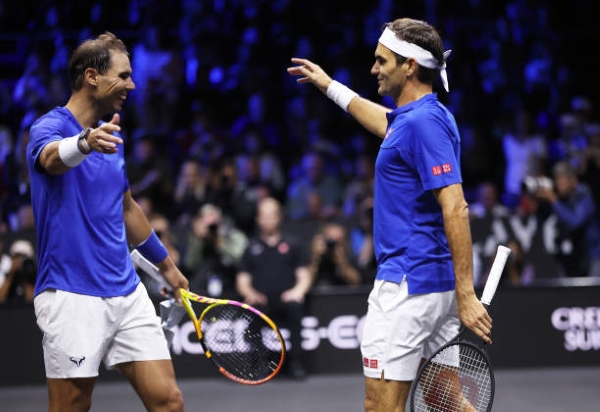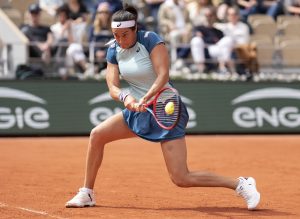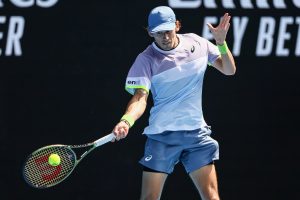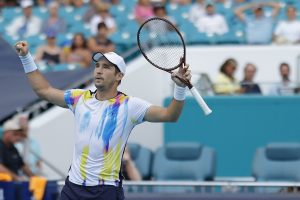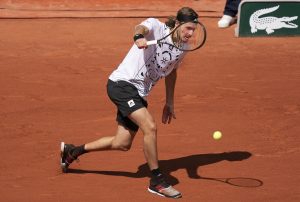In the second of his four-part series examining the extraordinary three-way “Trivalry” between Federer, Nadal and Djokovic, Martin Keady, our resident tennis historian, examines the specific rivalry between Federer and Nadal.
Before there was “The Trivalry” between Roger Federer, Rafael Nadal and Novak Djokovic, which has finally ended with Federer’s recent retirement, there was the original and more conventional two-way rivalry between Federer and Nadal. For nearly four years, before Djokovic won his first Major in Melbourne in 2008, the world of men’s tennis was bestrode by just two colossuses. And for many tennis fans, that original Federer-Nadal rivalry always remained the most iconic individual rivalry within the broader three-way Trivalry of Federer-Nadal-Djokovic.
The Ultimate Sporting Rivalry Between Almost Complete Opposites
Federer-Nadal was not only the original rivalry among the three greatest male tennis players of the last 20 years (who of course are also the three greatest male tennis players ever) but a classic rivalry between two players who appeared, at least initially, to be almost complete opposites. Federer was the supreme stylist, complete with one-handed backhand (the favourite shot of tennis aesthetes), who for five seasons – between 2003, when he won his first Wimbledon title, and 2007, when he won his fifth in succession, equalling Bjorn Borg’s record – seemed to glide not just above the court but above the sport.
In that period, Federer reached the kind of rarefied, even artistic heights that have only ever been matched by a handful of the most elite sportsmen: Diego Maradona and Zinedine Zidane in football; Viv Richards and David Gower in cricket; and Seve Ballesteros in golf. In short, at his absolute best, which he reached for two “twin peaks” in his career that came a decade apart (2004-07 and 2017-18), Federer was the greatest artist in the history of sport.
In complete contrast, Nadal was the ultimate competitor, a man who clearly didn’t give a fig about matters such as style or grace as he fidgeted and pulled at his own clothing and hair before proceeding to pull apart almost every opponent he faced, invariably bludgeoning them to defeat with his enormous forehand and even-more-enormous backhand.
If Federer appeared to have sprung fully formed from his own artistic imagination, Nadal was more like a Frankenstein’s monster of tennis, whose uncle and coach, Toni Nadal, deliberately made him play left-handed, even though he was a natural right-hander, with the aim of creating a player who virtually had a double forehand. Consequently, if Nadal ever lacked anything in elegance, especially in comparison with Federer, he made up for it with fighting spirit. If Federer was the greatest artist in the history of sport, Nadal is arguably the greatest competitor in the history of sport, a man who never gave up on a ball, however impossible it appeared to get to.
The History of the Federer-Nadal Rivalry
Almost from the beginning of Federer’s own Major-winning career, with that first Wimbledon title in 2003, Nadal was the hellhound on his trail. It is true that for the first few years, Nadal was almost exclusively a clay-court specialist, winning his first French Open in 2005 and dominating both Roland Garros and seemingly every other clay court in the world with his high-spinning and even higher-bouncing forehand, which left Federer and others trying to return it from a point somewhere above their head.
However, such was Nadal’s boundless competitive spirit that he was never going to be satisfied with just winning on clay, and so the battle between him and Federer was soon transferred to other surfaces, notably grass. In the mid-noughties, the two men seemed to split the tennis world neatly in two, with Nadal the King of Clay and Federer the King of Grass and (mostly) hardcourt. However, that strict dichotomy was shattered in the 2008 Wimbledon final when Nadal won arguably the greatest tennis match ever played by finally defeating Federer at Wimbledon and thereby denying him a record sixth successive men’s singles title.
FedHeds (Federer’s global army of fans) will forever regret the fact that Wimbledon did not put a roof over Centre Court a year earlier than it finally did. However, as Federer finally lost his Wimbledon title in the gathering gloom of July 2008, there was no denying that the first and imperial phase of the Federer-Nadal rivalry had ended, and with Nadal on top. And that impression was confirmed when Nadal also beat Federer in their next Major Final, the 2009 Australian Open Final, six months later.
The Late Phase Of The Federer-Nadal Rivalry
The emergence of Djokovic and to a lesser extent Andy Murray meant that men’s tennis in the second decade of the 21st century was no longer a duopoly but a three or even four-way fight between a number of all-time greats. Indeed, having contested so many Wimbledon, French Open and Australian Open Finals (remarkably, Federer and Nadal never met at the US Open, partly because Nadal often suffered late-season injury problems that prevented him reaching New York) in the mid to late noughties, Federer and Nadal only contested one other Major Final – the 2011 French Open Final, which Nadal typically won relatively easily – before the last phase of their rivalry, in the 2017 and 2018 seasons.
When Federer won the 2017 Australian Open Final, to claim his first Major title in nearly five years and after spending nearly six months off the ATP Tour with injuries, it was the first time that he had beaten Nadal in a Major Final in nearly a decade (since the 2007 Wimbledon Final). What followed was arguably even more extraordinary, as Federer, complete with a remodelled backhand specifically designed to counter Nadal’s two-handed backhand, went on to produce the last and arguably greatest phase of his career.
He won two more Majors (a record-breaking eighth Wimbledon title in 2017 and another Australian Open in 2018) and comprehensively defeated Nadal in both the Indian Wells and Miami Masters tournaments in 2017, producing possibly the greatest tennis he had ever played.
Even then, however, Federer could not shake off the hellhound that was Nadal. Nadal continued to win Majors himself, especially in Paris, and as Federer finally began to suffer from the niggling and persistent injuries that he had previously avoided for almost his entire career, Nadal (having always been behind Federer in Major victories) finally surged ahead this year. The Spaniard won both the Australian Open and the French Open to reach his current total of 22 Majors, two ahead of Federer’s 20.
Finally Friendly Rivalry Gave Way To Mutual Adoration
In the end, perhaps partly because Federer was for so long absent from the ATP Tour (he missed nearly three seasons in total) before finally confirming his retirement last month, what had always been a genuinely friendly and respectful rivalry gave way to almost complete mutual adoration – the bromiest of bromances. Federer was among the first to pay tribute to Nadal when Nadal won his 21st Major in Melbourne earlier this year and Nadal led the tributes to Federer upon the announcement of his retirement. Indeed, Nadal even said that he felt part of himself had retired, or been lost, with Federer’s retirement.
In a sense, of course, Nadal was absolutely correct, because the very greatest sporting rivalries yoke their individual members together forever. Like Ali-Frazier, Palmer-Nicklaus and even Real Madrid-Barcelona, the greatest sporting competitors are rarely defined singly but in direct comparison with each other. That is certainly true of Federer-Nadal, which is arguably the single greatest rivalry, because of its duration and sheer contrast of opposites, within the wider context of the great Trivalry of tennis.
Federer-Nadal’s Five Greatest Matches At The Majors
In tennis, the Majors rightly take precedence over everything else, so it is entirely appropriate, when considering the five greatest matches between Federer and Nadal, to focus on their five greatest matches at the Majors. Here they are, in reverse order.
- The 2019 Wimbledon Semi-Final: Federer Won 7-6 (7-3), 1-6, 6-3, 6-4
This was the last encounter at the Majors, indeed the last encounter in any professional tournament, between Federer and Nadal. Federer eventually won in four sets, after a first set that he narrowly won on a tie-break and a second set in which he was nearly bagelled by Nadal. Ultimately, however, it was the most Pyrrhic of victories for Federer, as the toll exacted by beating Nadal in the semi-final surely contributed to the excruciatingly narrow loss he suffered to Djokovic in the Final, when he held two match-points before finally losing 13-12 in the first ever final-set tie-break to decide a Wimbledon title.
- The 2007 Wimbledon Final: Federer Won 7–6 (9–7), 4–6, 7–6 (7–3), 2–6, 6–2
The 2007 Wimbledon Final is almost the forgotten Wimbledon Final, notwithstanding the fact that winning it gave Federer his fifth successive Wimbledon title. Of course that is because it was ultimately overshadowed by the following year’s Final (more of which shortly). Nevertheless, at the time it was widely described as the greatest Wimbledon Final since the classic Borg-McEnroe 1980 Final, which later became the subject of the greatest tennis film ever made (and arguably the greatest film ever made about any sport), Borg-McEnroe (2017).
- The 2009 Australian Open Final: Nadal Won 7–5, 3–6, 7–6 (7–3), 3–6, 6–2
It is entirely appropriate that four of the five greatest matches between Federer and Nadal at the Majors went to five sets; indeed, that is probably the greatest testament to the fierceness of their rivalry, with one player rarely able to exert dominance over the other for more than a set at a time. And at the start of 2009, Nadal confirmed that he finally had Federer’s number by beating him in a second successive five-set Major Final between the two.
- The 2017 Australian Open Final: Federer Won 6–4, 3–6, 6–1, 3–6, 6–3
It is fitting that in a recent BBC poll of tennis fans to find their favourite “Federer Moments”, the top two are also the top two on this list. That is because even amid all the great Federer-Nadal Major Finals, the top two stand apart as first and second among equals. The second favourite “Federer Moment” for respondents to the BBC poll was Federer’s late, great comeback victory, in the 2017 Australian Open Final against Nadal.
And if there had been a chance for FedHeds to vote for their favourite single set, they would surely have voted for the fifth set in Melbourne in 2017, when Federer somehow came from 1-3 down to reel off five games in a row and claim the title. It is not just Federer’s greatest single set (or near-set) of tennis, but probably the greatest single set (or near-set) of tennis that anyone has ever produced.
1.The 2008 Wimbledon Final: Nadal Won 6–4, 6–4, 6–7 (5–7), 6–7 (8–10), 9–7
It says everything about the healing effects of time and the greatness of the 2008 Wimbledon Men’s Singles Final that even FedHeds voted it their “Favourite Federer Moment” in the BBC poll. Although Federer ultimately lost that Final and with it his aura of invincibility on grass, it is still almost universally regarded as the greatest tennis match ever played. It is also a reminder that in the very greatest sporting contests – The Thrilla in Manila (Ali-Frazier 1975) or The Duel In The Sun (the 1977 Open golf shootout between Jack Nicklaus and Tom Watson) – there really are no losers. Everyone wins, and not just those competing, but those watching, because they have witnessed true sporting – indeed, true human – greatness.
Main photo:
Embed from Getty Images


